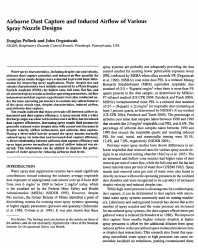Mining Publication: Airborne Dust Capture and Induced Airflow of Various Spray Nozzle Designs
Original creation date: July 2007
Water spray characteristics, including droplet size and velocity, airborne dust capture potential, and induced airflow quantity for various spray nozzle designs were evaluated to provide basic information for improving spray applications. Water droplet size and velocity characteristics were initially measured by a Phase Doppler Particle Analyzer (PDPA) for hollow cone, full cone, flat fan, and air atomized spray nozzles at similar operating parameters. Airflow inducement and dust capture experiments were also conducted under the same operating parameters to examine any salient features of the spray nozzle type, droplet characteristics, induced airflow, and airborne dust capture. Test results indicate that there are trade offs between airflow inducement and dust capture efficiency. A spray nozzle with a wider discharge angle was observed to induce more airflow, but at reduced dust capture efficiencies. Increasing spray nozzle fluid pressure(s) generally reduced water droplet sizes with concurrent increases in droplet velocity, airflow inducement, and airborne dust capture. Placing a three-sided barrier around the spray nozzles normally reduced spray air induction and increased dust capture efficiency. A direct relationship between airborne dust capture efficiency and spray input power normalized per unit of airflow induced was observed. This information can be utilized to improve the performance of water sprays for reducing airborne dust levels.
Authors: DE Pollock, JA Organiscak
Peer Reviewed Journal Article - July 2007
NIOSHTIC2 Number: 20032399
Aerosol Sci Tech 2007 Jul; 41(7):711–720
See Also
- Continuous Miner Spray Considerations for Optimizing Scrubber Performance in Exhaust Ventilation Systems
- Development of a Lower-Pressure Water-Powered Spot Scrubber for Mining Applications
- Dust Control Practices for Underground Coal Mining
- Effect of Water Sprays on Airflow Movement and Methane Dilution at the Working Face
- The Effects of Water Spray Placement for Controlling Respirable Dust and Face Methane Concentrations
- Effects of Water Sprays Used With a Machine-Mounted Scrubber on Face Methane Concentrations
- Evaluation of the Wet Head Continuous Miner to Reduce Respirable Dust
- Investigation of Longwall Face Ventilation Air-Splitting Methods for Improved Dust Control
- Use of a Directional Spray System Design to Control Respirable Dust and Face Gas Concentrations Around a Continuous Mining Machine
- Using Water Sprays to Improve Performance of a Flooded-Bed Dust Scrubber
- Content source: National Institute for Occupational Safety and Health, Mining Program


 ShareCompartir
ShareCompartir
